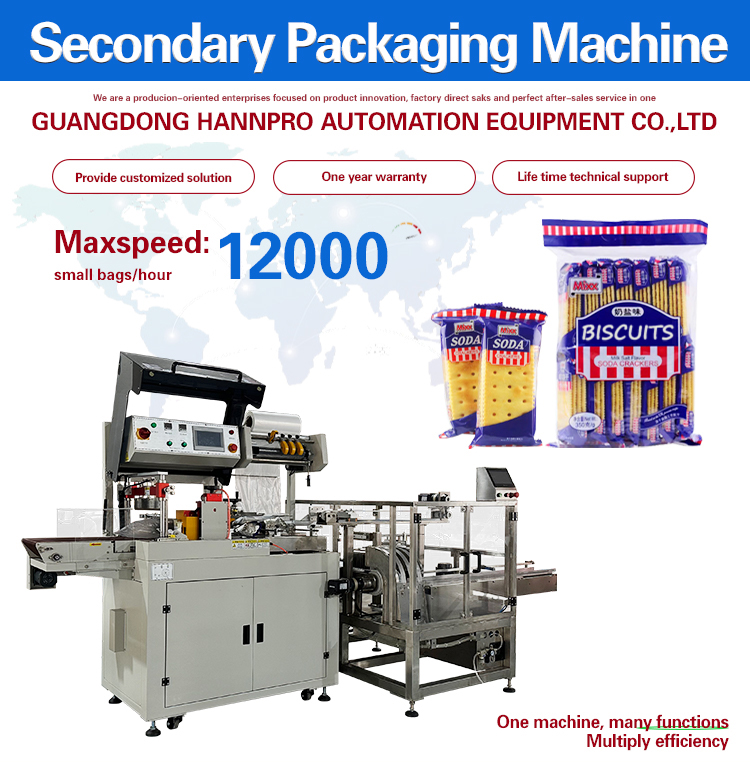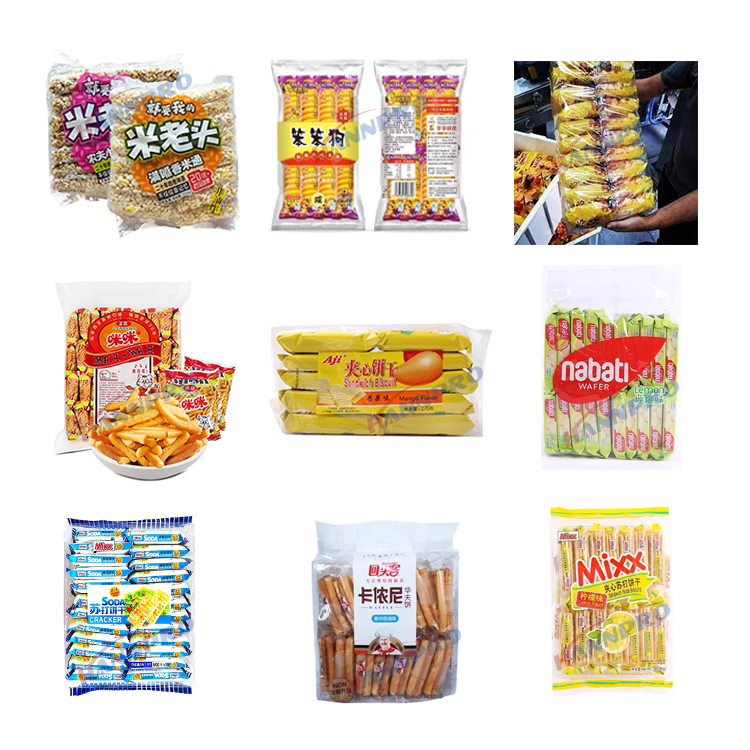"Secondary bagging machine for baked goods" refers to automated equipment specifically designed for secondary outer bagging of baked goods (such as bread, cakes, pastries, mooncakes, etc.) that have already undergone initial packaging (e.g., trays + cling film, inner bags, etc.). This type of equipment is widely used in the food industry to improve product appearance, extend shelf life, and facilitate transportation and sales.
**Automatic Bag Picking/Feeding:** Automatically retrieves pre-made bags (such as OPP, PE, composite film, etc.) from the bag storage mechanism secondary packaging machine.
Adaptable to different bag sizes biscuit secondary packaging machine; some models support automatic bag changing.
Automatic Bag Opening and Opening: Opens the bag opening using a vacuum suction cup or mechanical gripper.
Some high-end models are equipped with a vision recognition system to ensure accurate bag opening.

Automatic Feeding: Feeds the pre-packaged baked goods into bags via a conveyor belt, robotic arm, or pusher.
Can be integrated biscuit secondary packaging machine with upstream production lines for continuous operation.
Sealing Function: Heat sealing, ultrasonic sealing secondary packaging machine, or pulse sealing ensures a tight seal.
Optional functions include coding, labeling, vacuuming/nitrogen filling, etc.
Suitable for various product shapes
Supports square, round, and biscuit secondary packaging machine irregularly shaped baked goods.
Adjustable parameters to handle products of different weights and volumes secondary packaging machine.
Hygienic and safe design
Made of food-grade stainless steel, compliant with GMP/HACCP standards.
Easy-to-clean structure prevents cross-contamination cake secondary packaging machine.
Central factories for medium to large-sized bakeries
Distribution centers for cake chain brands
Mooncake and pastry manufacturers
Secondary packaging lines for frozen baked goods

Capacity matching: Select a model with a suitable secondary packaging machine packaging speed based on daily output.
Product compatibility: Confirm whether the equipment supports the size and shape of your products.
Automation level: Does it need to be linked with the front-end forming/initial packaging line? Does it need to integrate weighing and metal detection?
After-sales service: Prioritize suppliers with experience in the food industry and local service networks.
"Secondary bagging" of baked goods refers to sealing the product with an outer bag after the initial packaging (such as tray + cling film, inner tray + inner bag, individual small packages, etc.) to improve product appearance, prevent dust and moisture, extend shelf life, or facilitate transportation and sales. The packaging process and working principle are detailed below:
I. Typical Packaging Process (Taking an Automatic Secondary Bag Packaging Machine as an Example)
1. Product Input: The pre-packaged secondary packaging machine baked goods (such as bread with trays, cake boxes, individual small packages of pastries, etc.) are fed into the packaging machine inlet via a conveyor belt.
It can be integrated with upstream equipment (such as metal detectors, weighing machines) to achieve a fully automated production line.
2. Bag Retrieval & Opening: The machine automatically picks up a pre-made plastic bag (common materials: PE, OPP, CPP, or composite film) from the storage bin.
The bag opening is opened using a vacuum suction cup or pneumatic gripper secondary bagging machine, forming a "pocket" shape, ready to receive the new bag.
3. Product Bagging: Mechanical pushers, servo feeding mechanisms secondary bagging machine, or robotic arms precisely push the product into the opened bag.
Some models use a "drop-in" method: the product falls vertically into the bag from above (suitable for products with good stability).
4. Venting (Optional): For fluffy products (such as cakes and puffs), the machine may briefly evacuate or gently press to expel excess air from the bag, preventing it from bulging.
5. Sealing: The bag opening enters a heat-sealing device (constant-temperature hot knife, pulse heating, or ultrasonic sealing).
The seal is firm and flat biscuit secondary packaging machine. Some models can simultaneously perform: Printing production date/batch code (thermal coding or inkjet coding) Labeling Nitrogen filling for preservation (for high-requirement products)
6. Finished Product Output: The sealed bags are conveyed out via a conveyor belt to the boxing or palletizing stage.
The entire process typically takes only 2–5 seconds per bag, offering high efficiency and consistency.
[Initial Packaging] → Conveyor Belt → [Automatic Bag Pickup + Bag Opening] → [Product Push In] → [Exhaust] → [Heat Sealing + Coding] → [Finished Product Output]
Bag Material Selection: Transparency, heat-sealing properties biscuit secondary packaging machine, and barrier properties (e.g., moisture-proof, oil-proof) must be considered.
Product Stability: Fragile or irregularly shaped products require customized feeding mechanisms.
Cleaning and Maintenance: Residue must be cleaned after daily shutdown to prevent grease buildup from affecting the sealing effect.